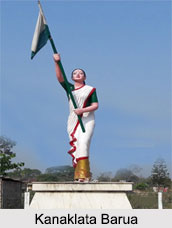 Kanaklata Barua was an Assamese freedom fighter and was also referred to as `Shaheed` or `martyr` and `Birbala` as she had been mercilessly shot dead while she was leading a procession carrying the Indian national flag, during the famous Quit India Movement of 1942.
Kanaklata Barua was an Assamese freedom fighter and was also referred to as `Shaheed` or `martyr` and `Birbala` as she had been mercilessly shot dead while she was leading a procession carrying the Indian national flag, during the famous Quit India Movement of 1942.
Early Life of Kanaklata Barua
Born to Krishna Kanta Barua and Korneshwari Barua on 22nd December, 1924 at Barangabari village of Gohpur sub- division of Sonitpur district, Kanaklata Barua was the youngest freedom fighter from Assam. Her grandfather, Ghana Kanta Barua was a reputed hunter in Darrang District. At an early age of only 5 years old, she lost her mother and her father remarried. When she was only 13, her father too died and she was left with the responsibility to look after her younger siblings.
The ancestors of Kanaklata Barua belonged to the kingdom of Dolakharia Barua of the erstwhile state of Ahom and they had renounced the title of Dolakharia. Instead they only retained the `Barua` title.
Kanaklata Barua as a Freedom Fighter
In 1942, when the freedom movement had reached its climax and Gandhi launched the Quit India Movement, the patriotic waves of this national upsurge was widespread and was even felt in Assam. It was during this time that the Indian National Congress organised a death squad called the "Mrityu Bahini" of which Kanaklata Barua was a part of. The group involved youth members of the subdivision of Gohpur in Assam.
In the state of Assam, the purpose of the "Mrityu Bahini" was to hoist the Indian national flag at the regional police station on 20th September, 1942. Inspired by the sheer bravado of the 17 year old Kanaklata, several unarmed youngsters and villagers marched towards the police station despite the repeated warnings of Rebati Mahan Som, the officer-in-charge of the station. Undeterred by the police, the procession continued marching ahead when the police fired upon the procession. Leading the procession was Kanaklata, who was shot dead and her flag was then taken by a villager known as Mukunda Kakoti who was also shot by the police. Kanaklata Barua thus lost her life fighting for her motherland when she was only 17.
Commemorating Kanaklata Barua
A life size sculpture of Kanaklata Barua was established at Gauripur in the year 2011. The Fast Petrol Vessel of ICGS Kanaklata Barua of the Indian Coast Guard had been commissioned in the year 1997.



















